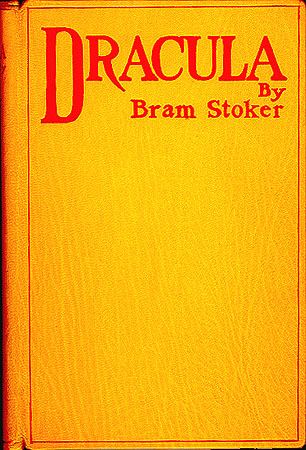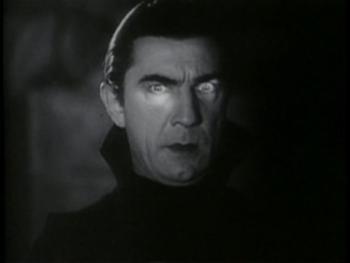I have previously posted about the Wandering Jew in Gothic fiction, which can be read at: https://thegothicwanderer.wordpress.com/2013/02/28/the-wandering-jew-a-staple-of-the-gothic-wanderer-tradition/
Following is an excerpt from my book The Gothic Wanderer: From Transgression to Redemption about Dracula’s Wandering Jew Origins:
Stoker’s ambiguity about Dracula’s origins is part of his novel’s strength but a frustration for the literary critic. It is impossible to know how easily Victorian readers accepted the plausibility of Dracula’s existence. Readers today cannot recreate such an experience because our culture is saturated with images of vampires that make readers knowledgeable about Dracula from childhood; consequently, those who read Dracula today are already willing to suspend their disbelief. Stoker’s personal feelings toward his famous character are equally difficult to determine; he appears to have both loathed and sympathized with Dracula, and therefore, placed Dracula in the role of outcast, a role with which Stoker, as an Irishman living in England, may have identified. Dracula’s role as racial outsider results from Stoker giving him Jewish attributes and largely basing him on depictions of the Wandering Jew. Although not Jewish, Stoker’s first name, Abraham, may have resulted in people believing he was Jewish. His role as Irish outsider may have further allowed Stoker to identify with the Jews as outcasts. Finally, Stoker’s homosexual inclinations meant he had to hide his true nature, so Stoker may have felt he was living under a false identity as Dracula must conceal his vampirism to survive (Malchow 155). Dracula’s eroticism may have resulted from Stoker’s own repressed sexuality. After 1895, Oscar Wilde’s famous trial resulted in laws against homosexuality becoming stricter, meaning Stoker would have feared to have his homosexuality discovered. Stoker personally knew Oscar Wilde, so Wilde’s situation must have caused Stoker emotional turmoil. Stoker may have even loathed his own sexual inclinations because he feared the discrimination that resulted from Wilde’s trial. Consequently, Dracula’s roles as outsider, pseudo-Jewish, and sexually deviant may have been an embodiment of those personal qualities that most bothered Stoker. This personal self-loathing may have made Stoker both sympathize with Dracula and simultaneously detest him. Stoker’s sympathy toward Dracula resulted in Dracula’s redemption, but Stoker’s personal self-hatred prevented Dracula’s redemption from occurring by any means but violent destruction.
Besides his possible personal identification with the Jews as outcasts, Stoker was very interested in the legend of the Wandering Jew, whose attributes are echoed in Dracula. Stoker may have known the works of Lewis and Maturin, but he was most fascinated by French author Eugene Sue’s The Wandering Jew (1845), which depicts the figure as a rebel and Romantic wanderer who achieves the reader’s sympathy by his benevolence toward humanity. The Wandering Jew becomes the hero of the work by defeating humanity’s real enemies, the Jesuits (Malchow 149, 156). Stoker’s fascination with Sue’s novel resulted in his heavily researching the Wandering Jew legend in the British Museum, as he did with the vampire legend. Stoker’s friend, Hall Caine, later remarked that the Wandering Jew became “one of Bram’s pet themes” (Malchow 156), and Stoker would include a section on the Wandering Jew in his book on famous impostors (Malchow 156). As secretary to the famous actor Henry Irving, Stoker even suggested that Irving perform a dramatic version of Sue’s novel (Malchow 156). There is good evidence, therefore, that Stoker intentionally used the Wandering Jew as a source for his depiction of Dracula.
Dracula’s debt to the Wandering Jew is most obvious in their shared physical characteristics. An 1873 stage version of Eugene Sue’s novel, produced by George Lander, describes the Wandering Jew as having “long jet-black hair and jet-black eyebrows, dressed in a long black robe” (Malchow 156-7). Dracula’s description is similar and may have been derived from Stoker’s memory of the play. Of course, the obvious physical similarity between the Wandering Jew and all vampires is the emphasis upon the eyes. Dracula has the same powerful hypnotic eyes attributed to the Wandering Jew, but Stoker also elaborates upon the eye description by giving Dracula’s eyes a red gleam suggestive of the “evil eye.” According to Matthew 6:22-3, the eye reflects the state of the soul, and Dracula’s eyes suggest this connection early in the novel. When Dracula makes his first appearance, his “eyes gleamed” (26), and later when Dracula sees that Jonathan Harker has cut himself while shaving, his eyes “blazed with a sort of demoniac fury” (34). Such descriptions reveal Dracula’s true evil nature (Wolf 10).
Dracula further shares with the Wandering Jew a supernaturally extended life. Both characters converse with great knowledge of the past, which amazes listeners who are ignorant of the speakers’ extensive ages. Such is Jonathan Harker’s experience upon first hearing Dracula’s conversation.
In his speaking of things and people, and especially of battles, he spoke as if he had been present at them all. This he afterwards explained by saying that to a boyar the pride of his house and name is his own pride, that their glory is his glory, that their fate is his fate. Whenever he spoke of his house he always said “we,” and spoke almost in the plural, like a king speaking. I wish I could put down all he said exactly as he said it, for to me it was most fascinating. It seemed to have in it a whole history of the country. (37)
While Dracula and the Wandering Jew share protracted lifespans, they are in opposition in their desires for such long lives. The Wandering Jew is weary of life and longs for death, but Dracula actively seeks to prolong his life by his supernatural activities. William Day observes that for Dracula to become supernatural, he must both be part of the natural world, while correspondingly reversing natural biological processes. In the natural world, the living feed on the dead, but Dracula is the dead who feeds on the living, and by this feeding he prolongs his life (41).
Dracula’s active desire to prolong his life is largely achieved by his ability to control Nature. By contrast, the Wandering Jew has no control over Nature, which acts against him as when the water recedes if the Jew attempts to drown himself, or the volcano spits out the Jew if he tries to jump in. Dracula, however, can control Nature, thus prolonging his life by his ability to move about in various forms, granting him numerous advantages and means for seducing potential victims while protecting himself from capture or destruction. In the novel, Dr. Van Helsing explains Dracula’s power over Nature:
he can, within limitations, appear at will when, and where, and in any of the forms that are to him; he can, within his range, direct the elements; the storm, the fog, the thunder; he can command all the meaner things: the rat, and the owl, and the bat—the moth, and the fox, and the wolf; he can grow and become small; and he can at times vanish and come unknown. (265)
Dracula’s control of the elements suggests his role as Antichrist because he has Christ-like powers. Christ is able to control the elements as in Mark 4:39-41 when he calms a storm at sea to protect his disciples. This idea of a Gothic character controlling the elements is not original to Stoker, who may have borrowed it from Bulwer-Lytton. In Bulwer-Lytton’s The Last Days of Pompeii (1834), the evil magician, Arbaces, is believed by the other characters to have control over the elements, and in the same author’s “The Haunted and the Haunters” (1857), a character remarks that a mesmerist, Richards, has similar powers: “I have seen him affect even the weather, disperse or collect clouds, by means of a glass tube or wand” (322). Dracula’s ability to “vanish and come unknown” also links him to the Wandering Jew who inexplicably can appear and disappear from places, especially at moments of historical importance. Stoker borrows the Jew’s mysterious movements for Dracula, but provides an explanation for how Dracula achieves such mobility.
Stoker also builds upon the Wandering Jew’s connection to the biblical Cain in his depiction of Dracula. The Wandering Jew traditionally bears a mark on his forehead that recalls the mark God gave to Cain for murdering Abel. Beirman states that Stoker was fascinated by the tale of Cain’s murder of Abel and planted the biblical story in the novel (Farson 155). Dracula receives a mark like that of Cain when Jonathan Harker strikes him upon the forehead. In revenge, Dracula places a mark upon Mina’s forehead, signifying that she belongs to him, so she is now an outcast from heaven like himself (Wolf 270). Dracula is further connected to Cain when his disciple, Renfield, refers to himself as Enoch, the biblical son of Cain (Farson 155).
Stoker made one final connection between Dracula and the Wandering Jew that he later deleted from the final version of Dracula. In the original second chapter that was later removed, Jonathan Harker’s journey to Dracula’s castle includes a stop in Munich, where he sees a performance of Wagner’s opera, The Flying Dutchman. The story of the Flying Dutchman is similar to that of the Wandering Jew; the Dutch captain must roam the seas forever in a cursed phantom ship until Judgment Day because he defied God by committing murder like the biblical Cain (Belford 217).
While Stoker’s interest in the Wandering Jew carried over into aspects of Dracula’s character, Stoker’s use of Jewish characteristics for Dracula also reflected the growing anti-Semitism of late Victorian England. Anti-Semitism was becoming popular at the end of the nineteenth century because of increased migrations of Eastern European and especially Jewish people into England (Zanger 34). During this period, the press continually discussed the Jewish “problem,” largely by attacking the immigration of Jews into England and the financial world, with which they were stereotypically associated (Malchow 130). While Stoker could have had his novel consist of Jonathan Harker’s visit to Transylvania, Stoker’s decision to have the novel center around Dracula’s migration to England is intended to symbolize the migration of Eastern European Jews to England in the late nineteenth century (Malchow 162). Dracula’s intent to colonize England with a race of vampires reflects an English fear that the Jews would take over England. The destruction of the “Jewish” Dracula becomes a “socially acceptable” way to express a widespread English desire to rid England of the Jews (Zanger 36). Stoker’s self-loathing of himself as an outcast, and his identification with the Jews as outcasts, may have contributed to his depiction of Dracula’s murder, thus granting the novel an anti-Semitic layer of meaning.
Besides his literary origins in the Wandering Jew, Dracula has numerous other Jewish attributes, especially his role as a racial outsider. Dracula fears recognition as an outsider while he is in England, so he explains to Jonathan Harker that he wishes to blend in with English society. Dracula’s role as “Other,” however, largely operates from his being a vampire and his perverse sexual behavior represented by his blood sucking. Dracula as “Other” poses a sexual threat in the novel that flourishes upon myths that Eastern and dark skinned men, including Africans and Jews, have greater sexual prowess than Western European men (Hatten 129, Malchow 149, 151). Such sexual fears of the “Other” resulted in numerous stereotypes of the Jewish people during the Victorian period, including their being rapists, cannibals, and polygamists. Dracula’s forced seduction of Lucy and Mina are symbolic of rape. Rape was an activity associated with Jews because of the murders committed by Jack the Ripper. Among the suspects for the identity of Jack the Ripper was a Jewish kosher butcher who had the instruments and the skills required to carry out the mutilations the Ripper inflicted upon his victims (Zanger 42). Of the one hundred thirty people questioned as suspects for being Jack the Ripper, a high proportion of them were Jewish, and ultimately, the police decided Jack the Ripper was probably a lower-class Jew from London’s East End (164). The widespread belief that Jack the Ripper was Jewish reflects the racism of Victorian England that sought to blame the Jews for its problems. Stoker capitalized upon this racist stereotyping by depicting Dracula as a sexual predator.
Besides being regarded as rapists, Jewish people were stereotyped with various forms of sexual deviance, including intended corruption of women and the innocent. In George DuMaurier’s Trilby (1894), Svengali the Jew has hypnotic eyes which he uses to seduce the heroine Trilby to carry out his will. Similarly, Dracula seduces Mina, and then tries to force her to help him in protecting himself from his enemies. Jews were also depicted as corrupting children. In Oliver Twist (1838), Fagin preys upon boys, using them as tools for his acquisition of wealth. More severe depictions included Jewish men as cowardly homosexual degenerates who preyed upon innocent boys; such representations easily extended to the metaphor that Jews were like vampires, for vampires seek their victims during nocturnal hours, the same time when homosexuals are most likely to contact one another (Malchow 141, 163). Vampires, Jews, and homosexuals were also all associated with strange smells believed to arise from the bodily emissions of masturbation or the fecund odor of sodomy (Malchow 141). Jewish men were even believed to menstruate; this bleeding provided yet another metaphorical link to vampires (Mulvey-Roberts, “Dracula” 830). After Oscar Wilde’s trial in 1895, anxieties increased over gender issues, and Stoker, who had his own anxieties over his homosexuality, used such anxieties to make Dracula all the more frightening by suggesting his sexual deviance (Gary Day 82).
More popular as a Jewish stereotype than their perverted sexuality was the belief that Jews were wealthy. Because many Jews were usurers, they were comparable to vampires because they could financially drain their debtors. Blood and money became metaphors for one another because both are necessary to sustain life. Consequently, Jews, and especially usurers, were treated as types of vampires in literature. In Mary Shelley’s Valperga (1823), usury is associated with vampirism when Castruccio, upon learning that Pepi has engaged in usury, calls Pepi, “Thou vile Jew…A usurer, a bloodsucker!” (216). In Charles Dickens’ Dombey and Son (1848), during an estate auction “herds of shabby vampires, Jew and Christian, over-run the house” (Pool 98). At least, Dickens admits that Christians can behave as badly as Jews. In Anthony Trollope’s The Way We Live Now (1875), the Jewish financier and swindler, Melmotte, is described as swallowing up the property of all whom he does business with, which is likened to his feeding upon the blood of widows and children (Zanger 38). Stoker builds upon such stereotypes by depicting Dracula as extremely wealthy and also miserly in his hiding of his money—he has a hidden treasure in Transylvania which is marked by a blue flame. Dracula’s extreme wealth is most dramatically depicted when the male protagonists attempt to capture Dracula at his London house. In the attack, Dracula’s clothes are torn, resulting in gold and bank notes falling from his clothing as if he were bleeding money (339). This scene recalls Shylock’s famous speech about Jews in The Merchant of Venice, “If you prick us, do we not bleed?” (III, i, 56) (Zanger 42).

Bela Lugosi, the most famous actor to play Dracula on screen in the 1931 film. When the film premiered, people in the audience were said to have fainted from the horror.
Stoker also uses typical stereotypes regarding the Jewish religion to enhance Dracula’s role as vampire. Jews were falsely believed to drink blood in their religious rituals, although the Old Testament specifically forbid blood consumption (Leviticus 10:14, Deuteronomy 12:23). Furthermore, Jews were frequently depicted as murdering Christians to obtain blood for their Passover feasts (Zanger 37). Dracula’s blood consumption, therefore, aligns his activities with the Jewish religion, and makes both appear as the reverse of Christianity. Dracula is likened to the vengeful God of the Old Testament, who demands blood sacrifices; therefore, Dracula’s blood consumption reflects the metaphor that the Jewish people’s Old Testament religion is a form of vampirism (Malchow 161-2).
These numerous Jewish attributes associated with vampires make Dracula the embodiment of a racist stereotype. His destruction, then, may be read as a form of racist murder and an attempt to preserve racial purity in England. At the same time, his outsider status makes him somewhat sympathetic to a modern reader. Dracula’s role as outcast is also based in his Jewish attributes because like the Jews, he is denied the salvation that Christians are promised. Dracula’s evil and supernatural nature and his blasphemy of Christianity ultimately cast him in the role of Antichrist.
________________________________________________
Tyler Tichelaar, Ph.D. is the author of King Arthur’s Children: A Study in Fiction and Tradition, The Gothic Wanderer: From Transgression to Redemption, and the upcoming novel Arthur’s Legacy, The Children of Arthur: Book One. You can visit Tyler at www.ChildrenofArthur.com and www.GothicWanderer.com



